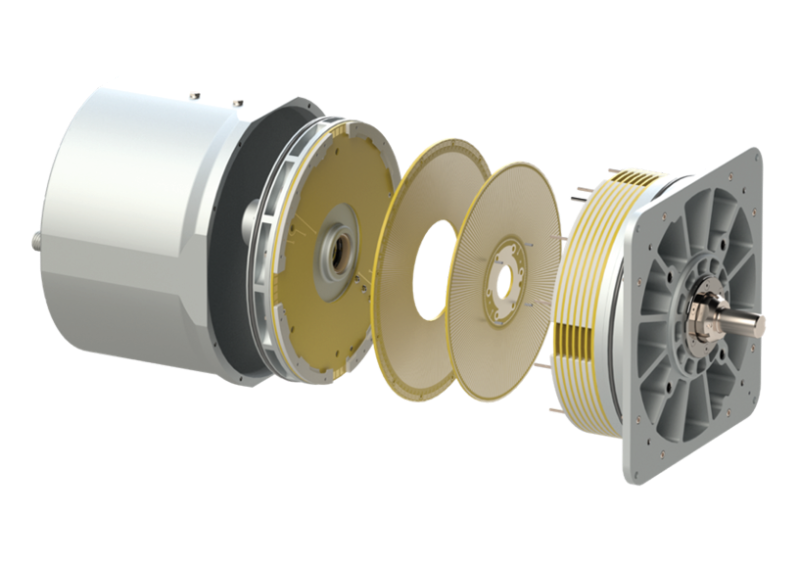Electrostatic motors are now common in MEMS applications, but researchers at the University of Wisconsin and spinoff C-Motive Technologies have brought macroscale electrostatic motors back. [via MSN/WSJ]
While the first real application of an electric motor was Ben Franklin’s electrostatically-driven turkey rotisserie, electromagnetic type motors largely supplanted the technology due to the types of materials available to engineers of the time. Newer dielectric fluids and power electronics now allow electrostatic motors to be better at some applications than their electromagnetic peers.
The main advantage of electrostatic motors is their reduced critical materials use. In particular, electrostatic motors don’t require copper windings or any rare earth magnets which are getting more expensive as demand grows for electrically-powered machines. C-Motive is initially targeting direct drive industrial applications, and the “voltage driven nature of an electrostatic machine” means they require less cooling than an electromagnetic motor. They also don’t use much if any power when stalled.
Would you like a refresher on how to make static electricity or a deeper dive on how these motors work?
















Near the bottom of the article:
At 1.5 T, a field achievable with iron, the theoretical magnetic shear limit is 1.79 MPa or 260 psi. At 3 kV/mm with atmospheric conditions, the theoretical electric shear limit is 79.65 Pa or 0.012 psi, a ~4 orders of magnitude deficiency for electrostatics compared with magnetics
And apparently nobody ever built a bigger motor then about 75Watt and an efficiency of 50% These are not going to replace big motors anytime soon. I’d be curious to see (niche?) applications where these motors are a good fit though.
Like we already learned at the university (electrical engineering): The energy density of the magnetic field is several magnitudes higher than the electrical field. And that’s the reason, there are nearly no electrostatic motors.
Yes, unless you view the magnetic field as a relativistic side effect of the electrostatic field, then suddenly all motors turn into electrostatic motors.
There’s a company selling a 1HP electrostatic motor, so largely above 75W. As for the air disruption voltage, the solution is so obvious it’s not a problem per se. Those motors are bathed in a non conductive liquid, so they handle a much larger voltage without arcing. The name of the company is in the article, please read it first before commenting.
Umm.. any liquid that is denser than air is going to induce more drag and lead to loses. Since liquids tend to be an order of magnitude denser than air it reasonable to assume that the drag would be an order of magnitude greater as well.
I think it’s not impossible that there is a liquid that allows you to produce enough torque at a slower speed where there’s less drag to come out ahead.
turkey rotisseries?
One thing that electrostatic motors do well is holding torque. With conventional motors, torque is proportional to current and speed is proportional to voltage, but it’s the other way around for electrostatic motors; this means that a stationary motor requires no power to maintain a holding torque until it starts moving. This could be useful in reducing power consumption for motors that spend a lot of time stationary, such as stepper motors.
I think these might be of interest for use in aerospace applications because they can be constructed from lighter materials and aren’t impacted by temperature. High temperatures are a serious problem as they will depolarize permanent magnets.
High temperatures can also depolarize many ceramic dielectrics.
Space applications also have fewer arcing problems since there’s no atmosphere.
Another clickbait headline.
“Making A Comeback”
The paper was published 4 years ago and no products are on the market.
“C-Motive” is designing these motors, but they only have a bulky 360 watt prototype that requires 2000 Volts. I’m sure there are some niche applications for that. If they are able to make it more compact and more powerful it might have more applications. But until then there is no comeback.
Ironically, I’m working on something now where one of these would be ideal. I’m rebuilding an old motion-picture camera and I have to hold winding torque on the 1000′ reels of film in the mag for extended lengths of time
I’m using a couple of BLDC’s in torque mode, and they work fine, but it would be really nice to have a motor that would stall gracefully and hold that stall torque without consuming power (it’s a battery powered device, after all)
Electrostatic motors may have advantage in orbital vacuum.space. can be designed to unlimited size and power.
Electromagnetic motors don’t require unsafe voltages. It’s nice not needing CRT flybacks anymore.
Neither do electromagnetic motors, though? There’s nothing stopping you from using aluminum windings and field coils, or non-rare-earth magnets like ferrites. Weird level of misinformation here.
Not even close to as efficient, either in energy or weight.
OK, silver then?
M: By weight aluminum is twice as conductive as copper or silver.
aluminium definitely wipes the floor with copper when weight/resistance is a concern…almost all high tension wiring uses aluminium as the conductor. The problem is the low density (in a motor any savings on the weight by using Al conductors get eaten by the iron core needing to be larger to fit the larger crossection of conductor) and lack of mechanical fatigue limit.
Still beats an electrostatic motor lol